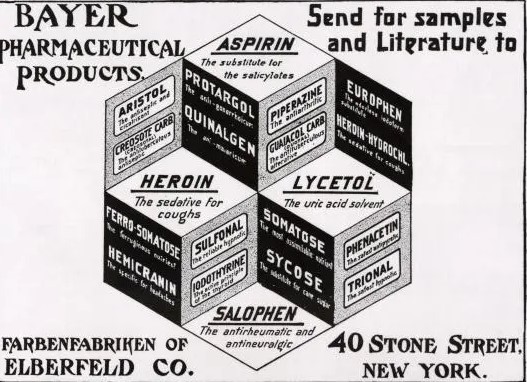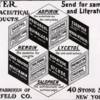Advertisement for Cocaine Toothache Drops,1890. Courtesy National Library of Medicine. (Credit: Smith Collection/Getty Images).
Author: Brynn Holland's article, please click here.
Why were parents giving their children heroin in the 1880s?
2. Cocaine—The Wonder Drug
Around the mid 1880s, scientists were able to isolate the active ingredient of the coca leaf, Erythroxylon coca (later known as cocaine). Pharmaceutical companies loved this new, fast-acting and relatively-inexpensive stimulant.
In 1884, an Austrian ophthalmologist, Carl Koller, discovered that a few drops of cocaine solution put on a patient’s cornea acted as a topical anesthetic. It made the eye immobile and de-sensitized to pain, and caused less bleeding at the site of incision—making eye surgery much less risky. News of this discovery spread, and soon cocaine was being used in both eye and sinus surgeries. Marketed as a treatment for toothaches, depression, sinusitis, lethargy, alcoholism, and impotence, cocaine was soon being sold as a tonic, lozenge, powder and even used in cigarettes. It even appeared in Sears Roebuck catalogues. Popular home remedies, such as Allen’s Cocaine Tablets, could be purchased for just 50 cents a box and offered relief for everything from hay fever, catarrh, throat troubles, nervousness, headaches, and sleeplessness. In reality, the side effects of cocaine actually caused many of the ailments it claimed to cure—causing lack of sleep, eating problems, depression, and even hallucinations.
You didn’t need a doctor’s prescription to purchase it. Some states sold cocaine at bars, and it was, famously, one of the key ingredients in the soon-to-be ubiquitous Coca-Cola soft drink. By 1902, there were an estimated 200,000 cocaine addicts in the U.S. alone. In 1914, the Harrison Narcotic Act outlawed the production, importation, and distribution of cocaine.
5. Heroin—The Cure for a Cough
Pharmaceutical advertisement from a 1900 magazine, promoting the use of heroin for a cough. (Credit: Bettmann/Getty Images)
How do you cure one drug epidemic? Create a new drug. That’s what happened in the late 1880s, when heroin was introduced as a safe and non-addictive substitute for morphine. Known as diamorphine, it was created by an English chemical researcher named C.R. Alder Wright in the 1870s, but it wasn’t until a chemist working for Bayer pharmaceuticals discovered Wright’s paper in 1895 that the drug came to market.
Finding it to be five times more effective—and supposedly less addictive—than morphine, Bayer began advertising a heroin-laced aspirin in 1898, which they marketed towards children suffering from sore throats, coughs, and cold. Some bottles depicted children eagerly reaching for the medicine, with moms giving their sick kids heroin on a spoon. Doctors started to have an inkling that heroin may not be as non-addictive as it seemed when patients began coming back for bottle after bottle. Despite the pushback from physicians and negative stories about heroin’s side effects pilling up, Bayer continued to market and produce their product until 1913. Eleven years later, the FDA banned heroin altogether



Comments (0)